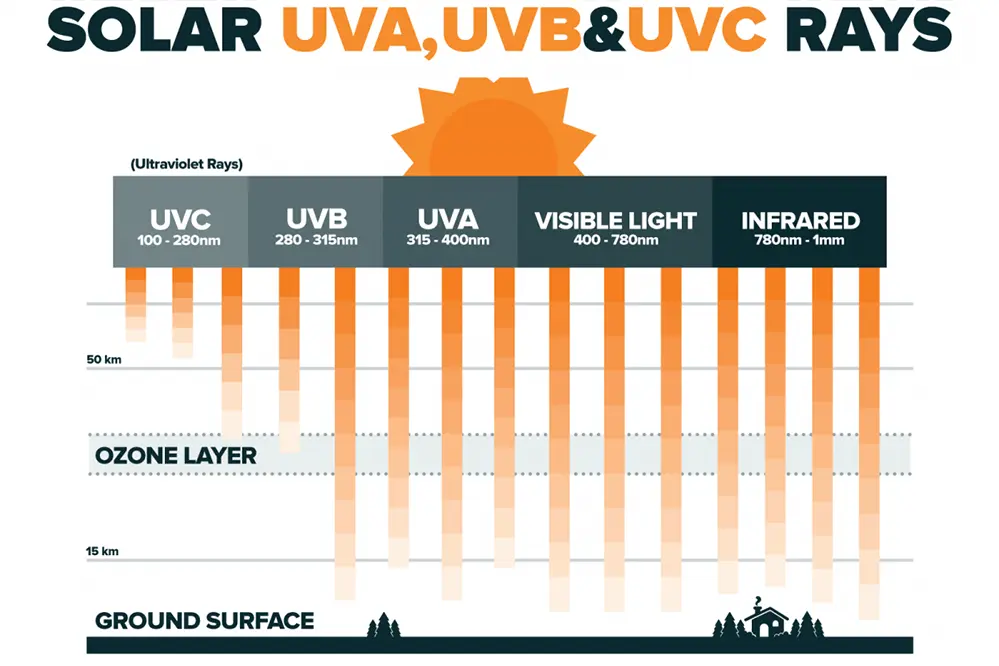Imagine the frustration of trying to set the perfect ambiance with your LED strip lights, only to find your remote control isn’t cooperating. This common scenario highlights the crucial decision between IR vs RF remotes to control LED strip lights. Understanding the differences between these two technologies can transform your lighting experience.
Did you know that RF remotes can operate through walls and obstacles, offering a range of up to 100 feet, while IR remotes require a direct line of sight? This surprising fact underscores the importance of choosing the right remote for your needs.
As we delve deeper into this topic, you’ll discover the advantages and limitations of each option, empowering you to make an informed decision for your lighting setup.
Understanding LED Strip Light Controls
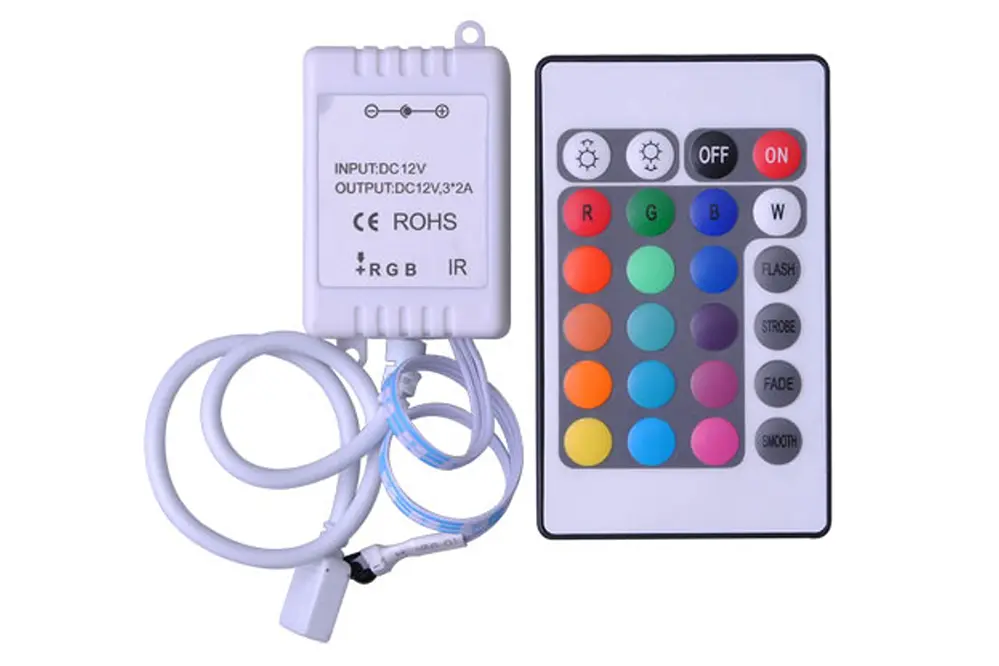
LED strip lights are a modern marvel.
Controlling these vivid tapes of light with the right power supply is imperative to maximizing their aesthetic potential. Whether it’s for creating ambiance, accentuating design features, or innovating spaces into personalized havens, seamless operation can transform the ordinary into the extraordinary. However, tapping into this magic requires understanding two pivotal control mechanisms that define user experience.
The crucial factors encompass range, reliability, and functionality.
The choice between infrared (IR) or radio frequency (RF) remotes – the two primary control methods – will shape the lighting dynamics from point A to point B. Both have distinct advantages and are partly reliant on personal preference and specific application needs.
Ultimately, gaining mastery over LED strip light controls through automation not only elevates the atmosphere but also catalyzes creativity, ensuring your living or working space continues to resonate with positive energy and innovation. By embracing the technology that best suits your requirements, you cultivate spaces that both inspire and illuminate, ready for the adventures ahead.
Introduction to IR Remotes
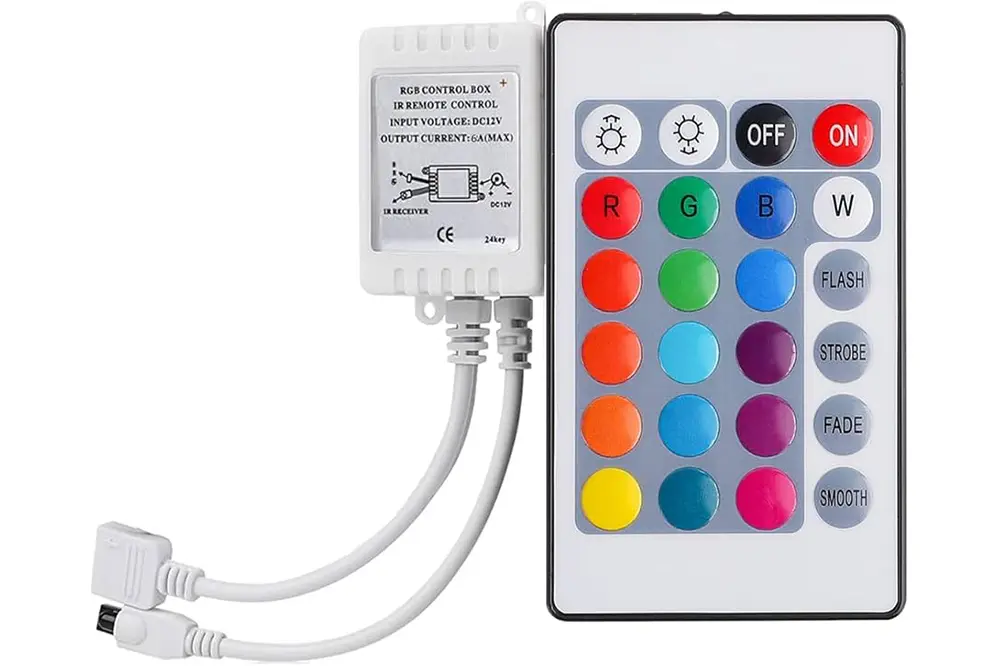
Infrared (IR) remotes represent a traditional yet reliable means for controlling LED strip lights. This control mechanism uses infrared light waves to transmit signals from the remote control to the receiving device on the LED strip.
Since 1975, when the first IR remote control broadcasting systems emerged, they have woven themselves into the fabric of modern convenience. Whether you’re changing a channel on a television or adjusting the brightness of your LED lighting setup, their user-friendly design enhances everyday experiences.
Today’s IR remotes for LED strip lights boast intuitive usability while offering precision in control. They allow users to manage an array of settings, such as changing colors, setting dynamic lighting modes, or adjusting brightness levels with remarkable ease. However, they do require a direct line of sight between the remote and the receiver.
Though the range is typically limited to around 30 feet, IR remotes excel in settings where proximity control is sufficient. They stand as champions of simplicity in environments where physical barriers don’t obstruct signals, rendering them a practical choice for home users looking for efficient, hassle-free control.
In conclusion, IR remotes hold a celebrated position in the world of LED strip light control thanks to their steadfast performance and simplicity.
Key Features of IR Remotes
IR remotes for LED strip lights bring a simplicity that balances a sleek operational experience. These remotes shine when a direct line of sight is feasible, offering users a reliable tool for control.
Designed to support essential lighting features, IR remotes facilitate easy modulation of color and brightness. Their small size makes them convenient for handheld operation.
Their straightforward nature allows users to breeze through diverse settings effortlessly, making them ideal for spaces where the remote and LED receiver are in immediate contact. This ease of use remains a defining trait.
The quintessential feature of IR remotes, however, lies in their specialized functionality. They operate without the need for intricate setups or complex programming, making them a preferred choice for those who value hassle-free installation and intuitive handling. By harnessing the direct signal method, users experience virtually instantaneous responses, ensuring your lighting preferences are just a button away.
Benefits of Using IR Remotes
Infrared (IR) remotes exhibit a range of benefits for LED strip light control, most notably their simplicity and reliability.
Their unpretentious design allows effortless use and ensures a smooth user experience.
Cost-effectiveness stands as another advantage, making IR remotes an economical choice for those seeking a simple yet functional lighting control solution. Without requiring lengthy configurations or sophisticated technology, IR remotes maintain accessibility, enhancing their appeal to a wide array of users.
The direct line-of-sight requirement fosters a unique stability which many users find reassuring. This aspect contributes to the remarkably low latency observed, as transmission signals face minimal interference. In environments where reliability and immediacy in response are paramount, IR remotes offer a dependable approach, embodying efficiency in seamless coordination between the remote and LED strip lights.
Limitations of IR Remotes
While IR remotes champion simplicity, they are not without their limitations concerning the realm of advancing technology.
IR remotes necessitate a direct line of sight to the LED strip light receiver, which can hinder usability in areas with obstructions or multiple angles. This need for alignment limits the flexibility that users may desire in controlling their environment and can detract from the convenience many have come to expect.
Moreover, the range of IR remotes is relatively constrained compared to their RF counterparts, typically effective only within a short distance. This characteristic can be particularly restrictive in large or open spaces, where expansive coverage is essential to achieve the desired lighting effect. The necessity for proximity compels users to be physically present near the LED setup, thereby potentially affecting overall user satisfaction.
Another consideration is that IR remotes are sensitive to interference from other infrared-emitting devices. Household electronics like televisions and remote-controlled gadgets can inadvertently disrupt or confuse the signals, resulting in inconsistent performance. Such interference can reduce the operational reliability and necessitate reconsideration of remote placement within an entertainment or lighting setup.
Despite these challenges, IR remotes deliver reliable, tried-and-true performance under the right conditions. Understanding these constraints allows users to make informed choices based on their specific lighting needs.
Introduction to RF Remotes
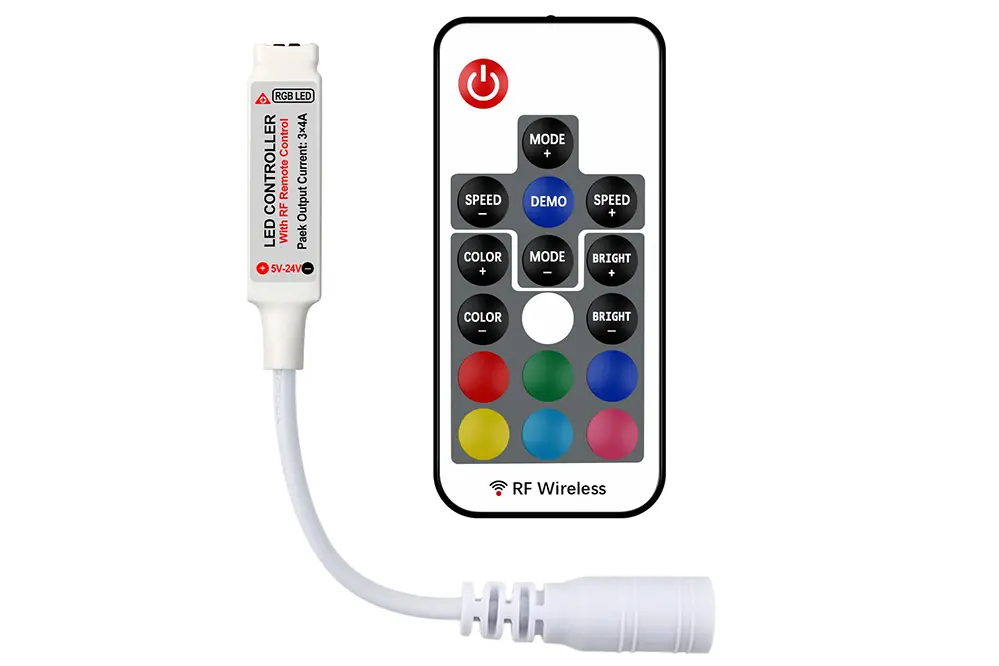
RF remotes, utilized for control, leverage radio frequencies to achieve seamless communication and expansive flexibility in operation.
In contrast to infrared remotes, RF remotes operate on a fundamentally different communication principle that provides a broader operational scope. They transmit commands via radio waves, allowing users greater freedom from the constraints of direct line-of-sight, an advantage that significantly enhances their functionality in diverse environments characterized by obstructions or varying layouts.
Consequently, this technology opens up a realm of possibilities for users seeking to create dynamic lighting atmospheres without the typical spatial limitations. It’s perfectly suited for elaborate setups, offering superior coverage and flexibility.
Furthermore, RF remotes present an enticing proposition for anyone eager to transform their LED strip light control experience. By embracing this advanced technology, individuals can effortlessly manage their lighting systems across multiple spaces, liberating themselves from the ordinary confines of traditional remote requirements.
Key Features of RF Remotes
RF remotes shine with versatility, enabling effortless LED strip light control across varied setups and spatial arrangements.
One of the most outstanding features of an RF remote is its ability to penetrate walls, offering users a newfound freedom and convenience. This capacity allows seamless operation even when located rooms away, transcending the barriers traditionally associated with infrared counterparts. Such robust communication ensures that your lighting control experience is as smooth and unrestricted as one could imagine.
Additionally, RF signals can cater to a remarkable range of up to 100 feet. By eliminating line-of-sight requisites, RF remotes not only enhance user convenience but also boost the potential for sophisticated lighting configurations in extensive or structural spaces.
This extraordinary range extends the reach of lighting control capabilities beyond mere proximity, encouraging innovation and creativity. Whether you’re organizing an event in a spacious venue or simply aiming to illuminate your home more effectively, RF remotes extend the boundaries of possibility, fostering an environment where ambitious lighting visions can be fully realized.
Benefits of Using RF Remotes
RF remotes offer unmatched versatility and convenience.
Unlike IR remotes, which rely on a direct line of sight, RF remotes provide a significant advantage by transmitting signals through obstacles. Walls, furniture, and even entire floors become non-issues, empowering users to control their LED strip lights with ease and precision. Consequently, RF remotes expand the possibilities of smart lighting design within any space.
Enjoy controlling your LED lighting with minimal spatial restrictions.
The ability to reach distances up to 100 feet – far beyond what traditional remotes typically manage – grants RF remotes the unparalleled capability to permeate even vast spaces. This makes them particularly invaluable for expansive home environments or commercial settings requiring comprehensive lighting solutions.
In today’s world, where the demand for smart, energy-efficient technologies is ever increasing, RF remotes stand at the forefront, transforming how we engage with ambient lighting. From enhancing everyday home comfort to redefining event atmospheres, the flexibility and freedom offered by RF remotes promise not only to meet but exceed expectations of contemporary users, unfolding boundless potential in LED strip light control.
Limitations of RF Remotes
While RF remotes boast substantial advantages, there are notable limitations that users should consider before choosing them for LED strip light control.
Foremost, RF remotes may suffer from a crowded frequency spectrum, leading to interference issues. This can be particularly problematic in densely populated areas where numerous devices operate on similar frequencies, potentially causing signal disruption and aberrant lighting behavior. Such challenges necessitate careful planning and thoughtful device coordination to maintain seamless operation.
Additionally, these remotes lack a visual confirmation of light status. In contrast to IR remotes that require direct line of sight, RF remotes can sometimes leave users guessing if the light has successfully been toggled when used from another room or lengthy distances.
Moreover, RF remotes might pose security concerns due to their wireless signals penetrating walls easily, which can expose them to potential interception by unauthorized users. It is crucial to implement robust security measures to prevent unintentional adjustments or breaches, ensuring that your smart lighting systems remain exclusively under your control and continue to illuminate your spaces securely and efficiently.
IR vs RF Remotes: Range Comparison
When exploring the dynamic spectrum of remote technologies, understanding the range capabilities of each system is paramount. In the battle of IR vs RF remotes to control LED strip lights, divergent range specifications offer distinct advantages.
Infrared (IR) remotes are known for their limited range, often constrained to approximately 30 feet.
Uniquely, these remotes require an undisturbed line of sight to communicate effectively with their targeted devices.
The restricted range of IR remotes makes them ideal for small, localized settings where control is kept within close quarters.
Conversely, RF remotes possess remarkable flexibility in their operational scope, thriving across distances of up to 100 feet or more.
This extended reach enables RF systems to surpass physical obstructions, offering an exhilarating wave of connectivity that defies barriers. Achieving broader coverage empowers users to liberate their creative layouts without sacrificing the control precision of their LED strip lights.
IR vs RF Remotes: Signal Interference
As we delve into the realm of signal interference, IR and RF remotes, along with considerations of energy efficiency, shine in different arenas based on their inherent designs.
Infrared (IR) remotes rely heavily on direct line of sight.
Any obstructions between the remote and the LED strip light receiver will disrupt signal transmission, resulting in a momentary lapse of control. Such sensitivity to interference necessitates careful placement of devices, ensuring no physical barriers impede the line of communication between the remote and the receiver.
In contrast, RF (Radio Frequency) remotes offer a striking ability to penetrate walls and obstacles, thus exhibiting exceptional resilience against signal interference. This capacity to bypass physical impediments provides a vast landscape for creative integration of LED strip lights in varied environments. By embracing RF technology, users can confidently configure their lighting aesthetics, knowing that the signal will withstand most common obstacles.
IR vs RF Remotes: Installation Differences
Installation varies for these remote systems significantly.
IR remotes require an unobstructed path for signal delivery. This means positioning the LED strip light receiver in visible and accessible locations, such as on the ceiling or open shelves. Consequently, installation must focus on the strategic placement of receivers to optimize signal reception and avoid disruptions.
RF remotes offer a more flexible installation process.
RF systems can be installed in areas that are out-of-sight, permitting receivers to be concealed behind furniture or within cabinetry. This flexibility allows for more creative freedom in integrating compatible LED strip lights into the existing decor without compromising control.
Ultimately, selecting between IR and RF remotes offers a choice between simplicity and versatility. While IR systems demand straightforward installations with a keen eye on line-of-sight requirements, RF configurations promise innovative applications with hidden receivers, offering a seamless aesthetic appeal that aligns with the modern design ethos of 2023 and beyond.
Compatibility with LED Strip Lights
Choosing between IR and RF remotes involves evaluating compatibility with your LED strip lights for optimal functionality and user experience.
IR remotes, due to their widespread adoption, often have a higher rate of compatibility with various LED strip light systems. Their technology is generally uniform, which simplifies integration across diverse brands and models, offering an ease of use that appeals to those seeking straightforward solutions. This universality ensures that IR remotes can be a reliable choice when predictability in pairing is a priority.
Conversely, RF remotes may necessitate a more specific alignment with LED systems. While they boast advanced features, ensuring that the remote’s frequency matches that of the strip light receiver is crucial for achieving seamless functionality and avoiding potential mismatches that could hinder performance.
In summary, while IR remotes add the convenience of broad compatibility with numerous LED strip systems, RF remotes deliver opportunities for enhanced control through selective integration. By understanding the nuances and aligning compatibility with technological aspirations, users can select the perfect remote that not only maximizes the functionality of their LED lights but also elevates the overall illumination experience.
Cost Comparison Between IR and RF
When evaluating the costs of IR versus RF remotes, the differences can be significant depending on the intended use and functionality desired.
IR remotes typically present a more budget-friendly option for consumers. The technology is simple and widespread, making it easier to produce and thereby keeping costs low.
RF remotes, while potentially more expensive, offer enhanced features and operational range. Their ability to penetrate walls and obstacles justifies the higher price point for many users who require such flexibility.
Although the initial expense of an RF remote may seem higher, the investment can pay off through increased convenience and broader application possibilities, particularly in environments where line-of-sight is impractical.
Ultimately, carefully considering your specific requirements and the associated costs can help you make an informed decision.
Ease of Use for Beginners
When it comes to the ease of use for beginners, infrared (IR) and radio frequency (RF) remotes each present unique benefits that cater to new users.
IR remotes are often lauded for their remarkable simplicity.
Typically, these remotes require only straightforward button presses, allowing newcomers to embrace them confidently with minimal learning curves.
However, RF remotes stand out by providing users with greater flexibility, requiring no direct line-of-sight operation.
This feature of RF remotes significantly simplifies control from different rooms, enhancing the user experience for those new to LED strip lighting.
Ultimately, the choice between IR and RF remotes will depend on the individual’s openness to learning new technologies. While IR remotes could be seen as easier initially, RF remotes might be more rewarding for those willing to explore their dynamic capabilities.
Popular Brands and Models
For LED strip lights, options abound.
Renowned brands have put forth their stellar remotes. One standout manufacturer is Lutron, recognized for its sophisticated solutions in lighting control, particularly their Caseta series. Another, Leviton, has carved its niche in the realm of wireless lighting systems. Meanwhile, Phillips Hue is often synonymous with cutting-edge innovation due to its seamless integration of lighting systems using both IR and RF technologies.
Lutron and Leviton serve diverse preferences.
For those who cherish precision, Lutron’s IR-based controls are a classic favorite. In contrast, Leviton’s RF remotes, with their advanced functionality, are an appealing choice for anyone seeking convenience beyond walls—a true testament to Leviton’s commitment to progressive technology.
Phillips Hue, with its vibrant ecosystem, champions the convergence of extraordinary functionality and aesthetic brilliance, consistently setting the gold standard in 2023. As such, trendy tech connoisseurs can rest assured that these prominent brands deliver both quality and innovation, crafting exceptional experiences tailored to every lighting need.
Choosing the Right Remote for Your Needs
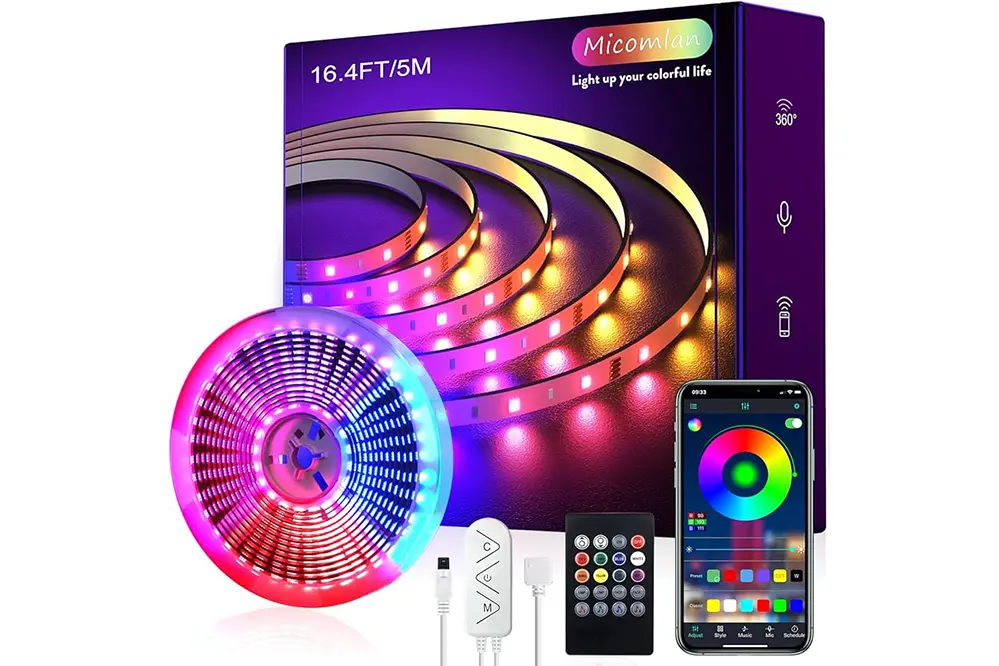
Take a deep breath and envision your ideal space.
The decision between IR and RF remotes hinges on your specific needs. An IR remote requires a direct line-of-sight to the LED strip controller, which might limit installation flexibility. Conversely, RF remotes penetrate walls and obstacles, offering unparalleled convenience across various environments without the constraints of direct alignment.
Determine your operational range priorities first.
If the freedom to control lights from – or through – other rooms and floors is a necessity, integrating an RF system becomes an undeniable asset. It supports multi-room setups conveniently while maintaining seamless, uninterrupted functionality.
In contrast, IR remotes can satisfy minimalist requirements with cost-effectiveness and straightforward installation. Both options echo the ability to transform ambiance, yet the choice should align with current lifestyle habits and any anticipated future needs. As 2023 progresses, let this exploration fuel an empowered decision-making process, ensuring the long-lasting impact of your lighting solution aligns with your aspirations.
Future Trends in LED Remote Controls
As we venture further into the future, innovative strides in remote control technology for LED strip lights promise to redefine user experience. With advancing developments, a diverse spectrum of possibilities becomes available.
Voice-activated systems are predicted to revolutionize the market, offering hands-free operation. With the rise of smart home integration, controlling lighting through voice commands brings unparalleled ease and adaptability.
Furthermore, gesture recognition emerges as an exciting breakthrough, potentially replacing conventional remotes altogether. This innovation enables fluid, intuitive control and offers a seamless user experience.
The increasing adoption of AI and machine learning introduces personalized lighting solutions that adapt to user preferences. This creates ambient themes automatically adjusted based on individual behaviors.
Ultimately, these upcoming trends reflect a shift towards a more sophisticated, interconnected, and user-centric approach. Embracing these technologies enables consumers to embark on a thrilling journey where lighting mirrors their unique lifestyle.
Indeed, the horizon holds boundless possibility, ensuring LED lighting transforms into an intrinsic element of modern living. Prepare to embrace this radiant future with optimism and enthusiasm.
Conclusion
When evaluating IR vs RF remotes for LED strip light control, it’s essential to recognize the unique benefits each technology offers. IR remotes are celebrated for their straightforward simplicity, making them ideal for scenarios requiring direct line-of-sight control. This ease of use appeals to those seeking a no-fuss solution for their lighting needs. On the other hand, RF remotes shine in their ability to operate through walls and obstacles, providing unparalleled freedom and convenience. This capability is particularly advantageous for users who desire flexibility in controlling their lighting environment from various locations within their home or office.
The decision between IR and RF remotes should be guided by specific use case requirements and personal preferences. Factors such as range, potential interference, and budget play crucial roles in determining the most suitable option. LED strip light enthusiasts are encouraged to weigh these considerations carefully to ensure optimal satisfaction and performance. Ultimately, the choice between these remotes transcends mere technological preference; it embodies a commitment to creating a customized and effortlessly controlled lighting experience that enhances both ambiance and functionality.

